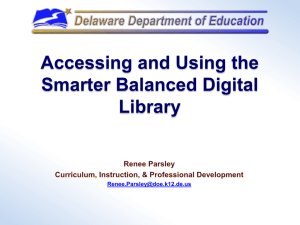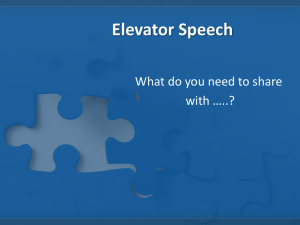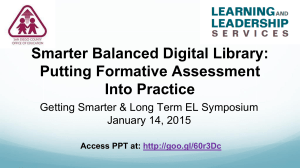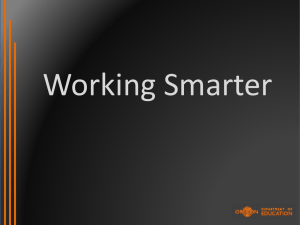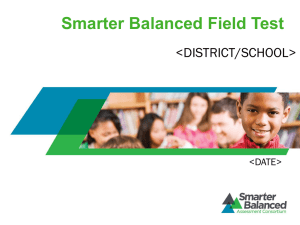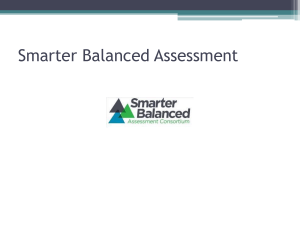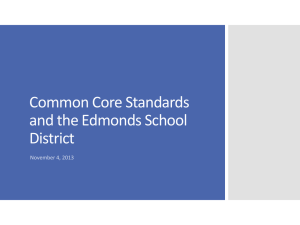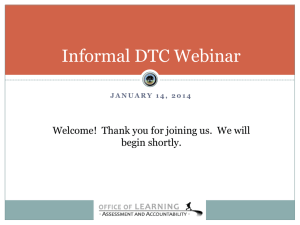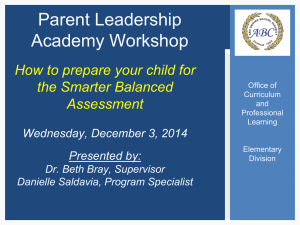Smarter Balanced Digital Library
advertisement
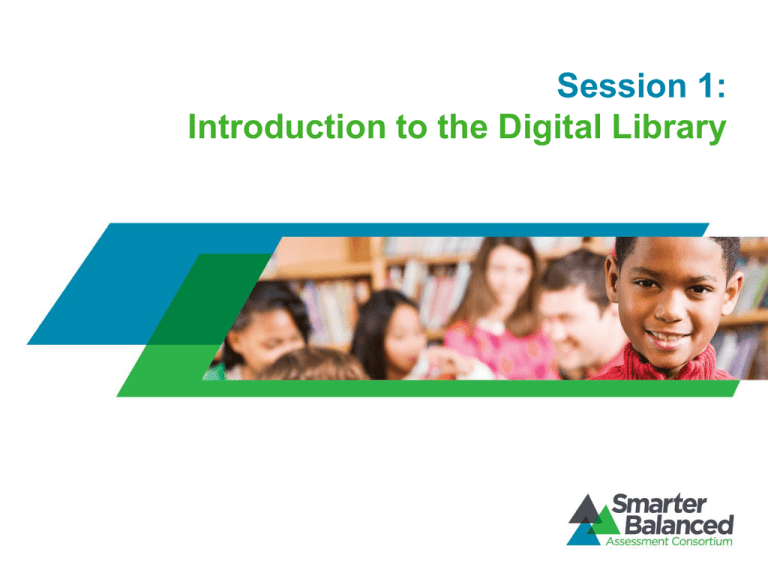
Session 1: Introduction to the Digital Library Session Overview Your facilitator, ___________________. [Add details of facilitator’s background, including a photograph] Page 2 Agenda • • • • • Setting the Stage Smarter Balanced Vision and the Digital Library Formative Assessment Process The Resource Posting Process and the Role of the SNE and SLT Reflecting on the Learning Page 3 Overview of Training Series 1 Session 1: Session 2: Session 3: Session 4: Introduction to the Digital Library Introduction to the Quality Criteria Submitting Quality Resources Navigating the Digital Library (1 hour) (1 hour) (3 hours) (1 hour) SLT two-day training Page 4 Educator Learning Targets • I understand the vision and mission of the Smarter Balanced Assessment Consortium. • I understand the Smarter Balanced Assessment System. • I understand the purpose and components of the Digital Library. • I understand the Smarter Balanced definition of the formative assessment process. • I understand the resource posting process and my role as an SNE or SLT member. Page 5 Educator Success Criteria • • • • • • I can explain the Smarter Balanced approach to supporting teaching and learning. I can explain how the Smarter Balanced assessment system is similar to and different from the assessment system I am currently using. I can explain why Smarter Balanced decided to create the Digital Library. I can describe the three different types of resources found in the Digital Library. I can identify the four attributes of the formative assessment process and how this process aligns with my own thinking. I can identify key educator roles in the resource posting process. Page 6 Agenda • • • • • Setting the Stage Smarter Balanced Vision and the Digital Library Formative Assessment Process The Resource Posting Process and the Role of the SNE and SLT Reflecting on the Learning Page 7 Smarter Balanced is committed to providing resources and tools to help teachers become more effective in their real-time, classroom-based assessment activities to measure student acquisition of the Common Core State Standards. – Dr. Joe Willhoft, Executive Director, Smarter Balanced Assessment Consortium Page 8 The Smarter Balanced Assessment System The Smarter Balanced Assessment System is explained in this video. Page 9 What came before this session? Consortium comes together to develop a balanced assessment system. 2009 2010 Educators join state teams committed to developing the Digital Library. U.S. Department of Education awards grant to Smarter Balanced. 2011 Smarter Balanced submits a proposal for a grant to the U.S. Department of Education’s Race to the Top Assessment Program. 2012 Governing states approve the Formative Assessment Master Work Plan, which outlines the development of the Digital Library. Page 10 2013 2014 Formative Assessment Advisory Panel (FAAP) convenes to develop the Quality Criteria. Resources in the Digital Library Assessment Literacy Modules Exemplar Instructional Modules • Commissioned professional development modules • Resources for students and families • Frame formative assessment within a balanced assessment system • Articulate the formative assessment process • Highlight formative assessment practices and tools • Commissioned professional development modules • Instructional materials for educators • Instructional materials for students • Demonstrate/support effective implementation of the formative process • Focus on key content and practice from the Common Core State Standards for Mathematics and English Language Arts • High-quality vetted instructional resources and tools for educators • High-quality vetted resources and tools for students and families Education Resources • Reflect and support the formative process • Reflect and support the Common Core State Standards for Mathematics and English Language Arts • Create Professional Learning Communities * Resources include the following file types: Video, HTML5, Audio, PPT, Excel, Word, and PDF. Page 11 Resources in the Digital Library Assessment Literacy Modules Exemplar Instructional Modules • Not an assessment bank • Not an item bank • Not a learning management system where educators can register for training or receive credit by completing specific online courses • Not a library for general public (will require registration and login) • Not a site where any resource can automatically be posted; all resources must be vetted through the Quality Criteria Education Resources * Resources include the following file types: Video, HTML5, Audio, PPT, Excel, Word, and PDF. Page 12 Interactive Check-in How-to Video • Watch the quick how-to video before completing the first interactive check-in: – Video Link Page 13 Interactive Check-in Number 1 Part A: Why is the creation of the Digital Library key to fulfilling the vision of Smarter Balanced? Please click to respond: http://padlet.com/wall/Session1_SBACCheck1A Part B: Consider the third category of resources for the Digital Library: Educator Resources. What resources have you seen or created that are appropriate for inclusion in the Library? Please click to respond: http://padlet.com/wall/Session1_SBACCheck1B Page 14 Agenda • • • • • Setting the Stage Smarter Balanced Vision and the Digital Library Formative Assessment Process The Resource Posting Process and the Role of the SNE and SLT Reflecting on the Learning Page 15 Formative Assessment Process Defined Formative assessment is a deliberate process used by teachers and students during instruction that provides actionable feedback that is used to adjust ongoing teaching and learning strategies to improve students’ selfassessment, reflection and attainment of curricular learning targets/goals. Page 16 Four Attributes of the Formative Assessment Process The formative assessment process attributes are explained in this video. Clarify Intended Learning Elicit Evidence Act on Evidence Interpret Evidence Page 17 Interactive Check-in Number 2 How do the definition and the attributes of the formative assessment process fit with your own definition and practice? What is one new idea you have about the formative assessment process? Please click to respond: http://padlet.com/wall/Session1_SBACCheck2 Page 18 Agenda • • • • • Setting the Stage Smarter Balanced Vision and the Digital Library Formative Assessment Process The Resource Posting Process and the Role of the SNE and SLT Reflecting on the Learning Page 19 How Resources Enter the Digital Library The process is explained in this video. Page 20 How Resources Enter the Digital Library Page 21 Expectations of SLT and SNE Members SLT (8-12 members per State) SNE (70-150 members per State) Recruit, identify, and train SNEs. Help populate the Digital Library in advance of the March/April 2014 launch. Monitor and support SNE’s review of resources and make final posting decisions. Provide feedback on the resources in the Digital Library, the review and posting process, the Quality Criteria, and usability of the library. Provide feedback on commissioned and supplemental resources. Provide overall leadership to the SNE and administer stipends. • Review supplemental resources using Quality Criteria. • Submit additional resources for review. Use the Digital Library resources and collaboration tools for professional learning and instruction. Provide feedback on the resources in the library, the review and posting process, the Quality Criteria, and usability of the Library. Page 22 Agenda • • • • • Setting the Stage Smarter Balanced Vision and the Digital Library Formative Assessment Process The Resource Posting Process and the Role of the SNE and SLT Reflecting on the Learning Page 23 Reflecting on the Learning: Success Criteria • • • • • • I can explain the Smarter Balanced approach to supporting teaching and learning. I can explain how the Smarter Balanced assessment system is similar to and different from the assessment system I am currently using. I can explain why Smarter Balanced decided to create the Digital Library. I can describe the three different types of resources found in the Digital Library. I can identify the four attributes of the formative assessment process and how this process aligns with my own thinking. I can identify key educator roles in the resource posting process. Page 24 Congratulations! You have completed Session 1: Introduction to the Digital Library. Session 1: Session 2: Session 3: Session 4: Introduction to the Digital Library Introduction to the Quality Criteria Submitting Quality Resources Navigating the Digital Library (1 hour) (1 hour) (3 hours) (1 hour) SLT two-day training Page 25 Next Steps and Feedback You can find Session 2: Introduction to the Quality Criteria and a handout of the Quality Criteria here: http://www.amplify.com/ smarter-balanced-digital-library Please complete the online session evaluation: https://www.surveymonkey.com/s/SNESession1 If you would like additional information about the Smarter Balanced Assessment Consortium, please visit: http://www.smarterbalanced.org/ Page 26
